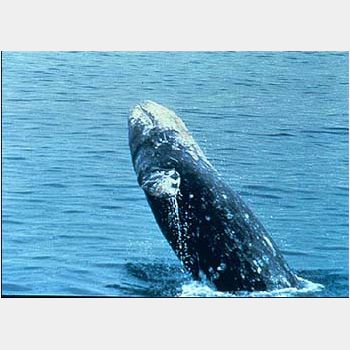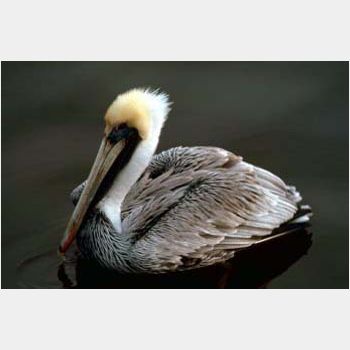Northwest Region
Species and Description
(click for a detailed technical account) |
Trend
(click to view literature citations and larger graph) |
States
(current and historic range)
|
Aleutian Canada goose
Branta canadensis leucopareia
 By the 1960's the Aleutian Canada goose was feared extinct due to the decline caused by the introduction of foxes onto the nesting islands. The goose has rebounded from a handful of remnant populations numbering as few as 790 individuals in 1975 to an estimated 37,000 in 2001, allowing the Aleutian Canada goose to be removed from the Endangered Species list. By the 1960's the Aleutian Canada goose was feared extinct due to the decline caused by the introduction of foxes onto the nesting islands. The goose has rebounded from a handful of remnant populations numbering as few as 790 individuals in 1975 to an estimated 37,000 in 2001, allowing the Aleutian Canada goose to be removed from the Endangered Species list.
|
|
AK(b), CA(s), OR(s), WA(m) --- |
Fin whale
Balaenoptera physalus
 Fin whales were hunted in all the world's oceans for the first three-quarters of the 20th century. There have been increases in both the North Atlantic and North Pacific populations in recent years. Fin whales were hunted in all the world's oceans for the first three-quarters of the 20th century. There have been increases in both the North Atlantic and North Pacific populations in recent years.
|
 |
AL(o), AK(s), CA(s), CT(s), DE(s), FL(s), GA(s), HI(s), LA(o), ME(s), MD(s), MA(s), MS(o), NH(s), NY(s), NJ(s), NC(s), OR(s), PA(s), RI(s), SC(s), TX(o), VA(s), WA(s) --- |
Blue whale
Balaenoptera musculus
 The blue whale was reduced by as much as 99% due to whaling that occurred until the mid-1960's. The number of whales reported off the coast of California increased from 704 in 1980 to an estimated 1,744 today. The blue whale was reduced by as much as 99% due to whaling that occurred until the mid-1960's. The number of whales reported off the coast of California increased from 704 in 1980 to an estimated 1,744 today.
|
 |
AK(s), CA(s), FL(o), HI(s), ME(o), MD(o), MA(o), NI(o), NH(o), NY(o), NC(o), OR(o), PR(o), RI(o), SC(o), VI(o), WA(o) --- |
Pacific green sea turtle
Chelonia mydas agassizii
 The Pacific green sea turtle occurs throughout the tropical and subtropical waters of the Mediterranean, Atlantic, Pacific and Indian oceans, but declined due to hunting and habitat loss to development. In Hawaii, greater than 90 percent of nesting occurs at French Frigate Shoals, and nesting females increased there from 75 in 1973 to 470 in 2003. The Pacific green sea turtle occurs throughout the tropical and subtropical waters of the Mediterranean, Atlantic, Pacific and Indian oceans, but declined due to hunting and habitat loss to development. In Hawaii, greater than 90 percent of nesting occurs at French Frigate Shoals, and nesting females increased there from 75 in 1973 to 470 in 2003.
|
 |
AS(b), CA(s), GU(b), HI(b), MP(b), OR(o), WA(o) --- |
Gray whale (northeast Pacific DPS)
Eschrichtius robustus pop. 3
 Gray whales declined preciptiously through the 17th and 18th century due to intense whaling. Although the number of gray whales has increased and the species is no longer considered endangered, it remains imperiled by ship strikes, coastal development, pollution, military activities, exploration and development of oil and gas resources. Gray whales declined preciptiously through the 17th and 18th century due to intense whaling. Although the number of gray whales has increased and the species is no longer considered endangered, it remains imperiled by ship strikes, coastal development, pollution, military activities, exploration and development of oil and gas resources.
|
 |
AK(b), CA(b), OR(b), WA(b) --- |
Arctic peregrine falcon
Falco peregrinus tundrius
 The use of DDT and other organochlorine pesticides resulted in reproductive failures in Arctic peregrines and caused their population to plummet. After DDT was banned, migration counts at the New Jersey Cape May Hawkwatch site saw the number of migrating Arctic peregrines increase from 103 in 1976, to 429 in 1992 (the species was delisted in 1994), to 1,017 in 2004. The use of DDT and other organochlorine pesticides resulted in reproductive failures in Arctic peregrines and caused their population to plummet. After DDT was banned, migration counts at the New Jersey Cape May Hawkwatch site saw the number of migrating Arctic peregrines increase from 103 in 1976, to 429 in 1992 (the species was delisted in 1994), to 1,017 in 2004.
|
 |
AL(m), AK(b), AZ(m), AR(m), CA(m), CO(m), CT(m), DE(m), DC(m), FL(m), GA(m), ID(m), IL(m), IN(m), IA(m), KS(m), KY(m), LA(m), ME(m), MD(m), MA(m), MI(m), MN(m), MS(m), MO(m), MT(m), NE(m), NV(m), NH(m), NY(m), NM(m), NJ(m), NC(m), ND(m), OH(m), OK(m), OR(m), PA(m), RI(m), SC(m), SD(m), TN(m), TX(m), UT(m), VT(m), VA(m), WA(m), WV(m), WI(m), WY(m) --- |
American peregrine falcon
Falco peregrinus anatum
 The use of DDT and other organochlorine pesticides resulted in reproductive failures in American peregrines and caused populations to plummet. After DDT was banned, the number of American peregrine pairs breeding in the U.S. increased from 324 in 1975 to 1,700 in 2000; the species was delisted in 1999. The use of DDT and other organochlorine pesticides resulted in reproductive failures in American peregrines and caused populations to plummet. After DDT was banned, the number of American peregrine pairs breeding in the U.S. increased from 324 in 1975 to 1,700 in 2000; the species was delisted in 1999.
|
 |
AL(m), AK(b), AZ(b), AR(m), CA(b), CO(b), CT(b), DE(b), DC(m), GA(b), ID(b), IL(b), IN(b), IA(b), KS(m), KY(b), LA(m), ME(b), MD(b), MA(b), MI(b), MN(b), MS(m), MO(m), MT(b), NE(b), NV(b), NH(b), NY(b), NM(b), NJ(b), NC(b), ND(m), OH(b), OK(m), OR(b), PA(b), RI(b), SC(b), SD(b), TN(b), TX(b), UT(b), VT(b), VA(b), WA(b), WV(m), WI(b), WY(b) --- |
California condor
Gymnogyps californianus
 The California condor had declined to just nine individuals in 1985 due to DDT, lead poisoning, and hunting. A successful captive breeding and reintroduction program has increased the 2005 wild population to 121 and the captive population to 158. The California condor had declined to just nine individuals in 1985 due to DDT, lead poisoning, and hunting. A successful captive breeding and reintroduction program has increased the 2005 wild population to 121 and the captive population to 158.
|
 |
AZ(b), CA(b) --- NV(x), OR(x), UT(x), WA(x) |
Humpback whale
Megaptera novaeangliae
 Humpback whale populations were greatly depleted by commercial whaling by the early 1900s. In 1966, the entire North Pacific humpback population was thought to number only around 1,200 animals; this estimate increased to between 6,000 and 8,000 by 1992. Humpback whale populations were greatly depleted by commercial whaling by the early 1900s. In 1966, the entire North Pacific humpback population was thought to number only around 1,200 animals; this estimate increased to between 6,000 and 8,000 by 1992.
|
 |
AL(o), AK(s), CA(s), CT(s), DE(s), FL(s), GA(s), HI(s), LA(o), ME(s), MD(s), MA(s), MS(o), NI(s), NH(s), NY(s), NJ(s), NC(s), OR(s), PR(o), RI(s), SC(s), TX(o), VI(s), VA(s), WA(s) --- |
California brown pelican
Pelecanus occidentalis californicus
 DDT pollution, eventually traced back to a Los Angeles area factory, resulted in declines in the California brown pelican population. The number of California brown pelican nests dropped to a low of 466 in 1974, began increasing in 1979, and by 1987 rose to 7,900 nests; since then nest numbers have fluctuated around a mean of 5,000. DDT pollution, eventually traced back to a Los Angeles area factory, resulted in declines in the California brown pelican population. The number of California brown pelican nests dropped to a low of 466 in 1974, began increasing in 1979, and by 1987 rose to 7,900 nests; since then nest numbers have fluctuated around a mean of 5,000.
|
 |
AZ(o), CA(b), OR(s), WA(s) --- |
Gray wolf (Western DPS)
Canis lupus (Western DPS)
 Hunting and persecution of gray wolves led to their extirpation in the western portion of the lower 48 states. Gray wolves began recolonizing the Rocky Mountain region in the early 1980s and currently 93 wolves are estimated to be in Montana, 294 in Greater Yellowstone, and 525 in Central Idaho. Hunting and persecution of gray wolves led to their extirpation in the western portion of the lower 48 states. Gray wolves began recolonizing the Rocky Mountain region in the early 1980s and currently 93 wolves are estimated to be in Montana, 294 in Greater Yellowstone, and 525 in Central Idaho.
|
 |
ID(b), MT(b), OR(o), WA(o), WY(b) --- CA(x), CO(x), NV(x), UT(x) |
Grizzly bear (Yellowstone DPS)
Ursus arctos horribilis (Yellowstone DPS)
 The killing of grizzly bears and the destruction and fragmentation of their habitat caused drastic population declines in the lower 48 states; by 1975 only six populations remained. The number of grizzly bears in the greater Yellowstone population has increased from an estimated 224 bears in 1975 to over 500 bears in 2005. The killing of grizzly bears and the destruction and fragmentation of their habitat caused drastic population declines in the lower 48 states; by 1975 only six populations remained. The number of grizzly bears in the greater Yellowstone population has increased from an estimated 224 bears in 1975 to over 500 bears in 2005.
|
 |
ID(b), MT(b), WA(b), WY(b) --- AZ(x), CA(x), CO(x), KS(x), MN(x), NE(x), NV(x), NM(x), ND(x), OK(x), OR(x), SD(x), TX(x), UT(x) |
Bald eagle (Continental U.S. DPS)
Haliaeetus leucocephalus (Continental U.S. DPS)
 The bald eagle declined throughout the Lower 48 states due to habitat loss and DDT application. The banning of DDT, increased habitat protection, and aggressive captive breeding and translocation programs caused the number of bald eagle pairs in the Lower 48 to soar from 416 in 1963 to approximately 9,789 in the latest census between 2004-2006. The bald eagle declined throughout the Lower 48 states due to habitat loss and DDT application. The banning of DDT, increased habitat protection, and aggressive captive breeding and translocation programs caused the number of bald eagle pairs in the Lower 48 to soar from 416 in 1963 to approximately 9,789 in the latest census between 2004-2006.
|
 |
AL(b), AZ(b), AR(b), CA(b), CO(b), CT(b), DE(b), DC(b), FL(b), GA(b), ID(b), IL(b), IN(b), IA(b), KS(b), KY(b), LA(b), ME(b), MD(b), MA(b), MI(b), MN(b), MS(b), MO(b), MT(b), NE(b), NV(b), NH(b), NY(b), NM(b), NJ(b), NC(b), ND(b), OH(b), OK(b), OR(b), PA(b), RI(b), SC(b), SD(b), TN(b), TX(b), UT(b), VT(b), VA(b), WA(b), WV(b), WI(b), WY(b) --- |
Western snowy plover (Pacific DPS)
Charadrius alexandrinus nivosus (Pacific DPS)
 The snowy plover declined on the Pacific Coast due to habitat loss, disturbance of nest sites, and encroachment of European beach grass. When listed as an endangered species in 1993, the U.S. population was estimated at about 1,500. By 2005, the number of populations had increased and the total population size had grown to 2,300. The snowy plover declined on the Pacific Coast due to habitat loss, disturbance of nest sites, and encroachment of European beach grass. When listed as an endangered species in 1993, the U.S. population was estimated at about 1,500. By 2005, the number of populations had increased and the total population size had grown to 2,300.
|
 |
CA(b), OR(b), WA(b) --- |
Columbian white-tailed deer (Douglas County DPS)
Odocoileus virginianus leucurus (Douglas County DPS)
 Un-restricted hunting and the clearing of riparian lands for agriculture drastically reduced Columbian white-tailed deer populations. In the 1930s, the Douglas County Columbian white-tailed deer populations was estimated at 200-300; by 1983 the population had increased to about 2,500 deer, and by 2003 when the species was delisted, the population numbered over 6,000. Un-restricted hunting and the clearing of riparian lands for agriculture drastically reduced Columbian white-tailed deer populations. In the 1930s, the Douglas County Columbian white-tailed deer populations was estimated at 200-300; by 1983 the population had increased to about 2,500 deer, and by 2003 when the species was delisted, the population numbered over 6,000.
|
 |
OR(b) --- |
|
|
(b) currently breeds, (s) seasonally present, (m) migration route, (o) occasionally present, (x) extirpated
|
 |


















PhillipColla.jpg)















